Formulation and Manufacturing of Infant and Toddler Foods
While many aspects of the formulation and manufacture of infant and toddler foods are common to the food industry, others are unique because of the special needs and expectations of the target consumers and their caregivers.
About 4 million babies are born in the United States each year. Infant and toddler foods usually represent children’s first exposure to a broad range of solid foods, contributing to both nutritional intake and development of eating skills during the first two years of life.
As would be expected, the infant and toddler food category is impacted by the same general factors that influence the entire food industry, such as economic conditions and demographics. And the category is specifically impacted by birthrates, breastfeeding patterns, high turnover of consumers, and competition. The major companies in the category are Gerber, Beechnut, and Del Monte, which acquired the Heinz baby food business last year.
The category is healthy, due in part to the on-going effort of manufacturers to add value through innovations related to safety, convenience, and nutrition. This article will describe a number of challenges involved in formulating and manufacturing food products for this unique segment of our population.
Formulation of Infant and Toddler Foods
Infant and toddler foods are subject to the same set of success factors that apply to the industry as a whole—e.g., meeting a consumer need and financial viability. What distinguishes this food category is the relative importance that must be placed on certain elements of product development, namely, safety, product purity (i.e., clean label), and developmental appropriateness. Although convenience and nutrition are not unique to the category, they are major drivers that influence practically every aspect of product and package development. With a few exceptions, infant and toddler products are shelf-stable and represent a fairly broad cross-section of food types.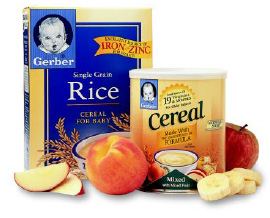
Among the core products for infants are instant cereals, juice, and purees made from fruit, vegetable, cereal, and meats. Cereals are usually baby’s first exposure to solid foods (Figs. 1 and 2). Purees are available as single-ingredient offerings and in a wide variety of combinations. Bakery and snack items are also available for older infants and toddlers. These consist of long-standing products such as teething biscuits, zwieback toast, and arrowroot cookies, along with an assorment of newer offerings, many of which are similar to adult products but adapted to meet the needs of toddlers and their caregivers (Fig. 3). Product lines targeted to toddlers are typically sub-branded to distinguish them from their infant counterparts, e.g., Gerber uses the Graduates® sub-brand and Beechnut® uses Table Time®.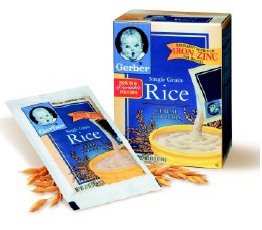
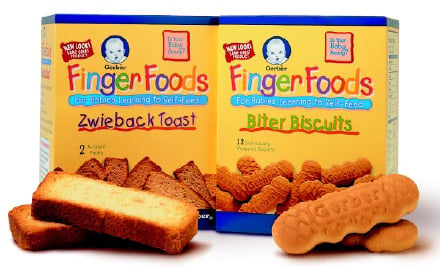 Both infant and toddler products have typically been offered as individual meal components that can be mixed and matched during feeding at the discretion of the caregiver. In 2002, Gerber introduced Lil’ Entrees®, the first line of mealtime combinations for older infants and toddlers, served in microwavable trays, which offer nutrition and convenience for on-the go parents (Fig.4).
Both infant and toddler products have typically been offered as individual meal components that can be mixed and matched during feeding at the discretion of the caregiver. In 2002, Gerber introduced Lil’ Entrees®, the first line of mealtime combinations for older infants and toddlers, served in microwavable trays, which offer nutrition and convenience for on-the go parents (Fig.4).
--- PAGE BREAK ---
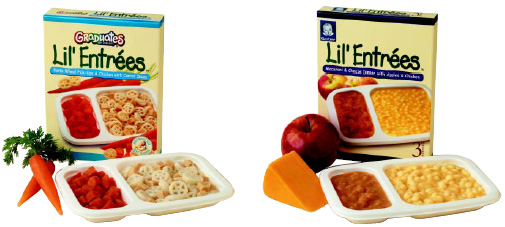 • Safety and Purity. The major safety concerns of microbiological, microphysical, or chemical contamination are primarily addressed in product safety, quality assurance, and manufacturing groups. The primary role of the product developer is to understand and adhere to these policies while formulating products that meet overall acceptance criteria.
• Safety and Purity. The major safety concerns of microbiological, microphysical, or chemical contamination are primarily addressed in product safety, quality assurance, and manufacturing groups. The primary role of the product developer is to understand and adhere to these policies while formulating products that meet overall acceptance criteria.
From a total quality standpoint, extra care is taken to meet the regulatory requirements, to cultivate supplier/grower relationships, to maintain state-of-the-art quality systems, and to ensure that ingredients meet strict specifications.
To maintain consumer trust, safety is given the highest priority. Infant food manufacturers often act proactively to exceed requirements set forth by regulatory agencies such as the Food and Drug Administration, the U.S. Dept. of Agriculture, and the Environmental Protection Agency. An additional 10-fold safety factor is typically applied to exposure estimates because of the young age of our target population.
Manufacturer policies include strict specifications for all ingredients. This is particularly important for the production of fruit and vegetable crops with respect to the use of crop protectants and the presence of environmental contaminants such as heavy metals and other pollutants. Gerber, for example, has maintained a database to record more than a decade of history among its growers, including detail involving specific fields and orchards. This program combines carefully designed growing practices and raw material specifications along with a detailed understanding of the impact of unit processes on post-process levels of these components. Co-manufacturers are required to purchase most raw materials from specific approved suppliers.
The vast majority of wet infant and toddler foods are still processed by hot–fill–hold or retort processes. Typically, retorted baby foods are subjected to rather conservative thermal processes to ensure a very low probability of spoilage or pathogen survival. Gerber has recently made improvements in its cooking method through its patented Nature Lock® process and its introduction of aseptically processed and packaged fruit purees in plastic, both of which improve overall quality and convenience of baby foods.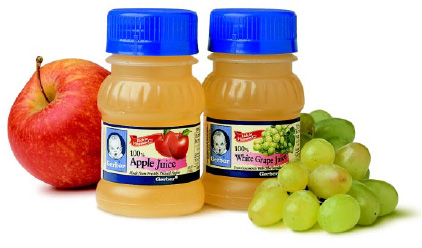
--- PAGE BREAK ---
Tamper evidence is a common feature of packaged foods. Jarred infant and toddler food items use a pop-up button on the cap that “pops” when the container is opened and releases vacuum. The vacuum is created in process as the product cools and steam condenses in the headspace. In some instances, there are dual modes of tamper evidence. For example, Gerber’s 4-oz juices in plastic bottles use a foil seal at the bottle opening coupled with a drop-band perforated to the cap (Fig. 5).
Pure products and clean labels are critical in infant and toddler foods. Therefore, a number of common, approved ingredients receive no or limited use in these categories. Most notable is the virtual absence of artificial colors, artificial flavors, and preservatives in the category. Some of their natural counterparts are used; however, this is generally limited to certain products for older infants and toddlers. Use of staple food ingredients such as salt, sugar, and starches is also limited, especially in the infant segment. Seasonings, herbs, and spices are sometimes used in foods for older babies. Non-blended purees generally contain only fruit or vegetable, vitamin C, and water for processing. Therefore, variety selection and processing conditions can play an important role in product acceptance.
The boundaries of ingredient usage likely exist as policies among the various manufacturers. Both usage and label statements are carefully scrutinized throughout the product development process. As highlighted here, flexibility is limited in product formulations, and there are certainly instances where product purity overrides potential taste; however, developers often meet this challenge.
• Developmental Appropriateness. Infants and toddlers are not little adults; they are unique in many ways. Among them is the rapid rate of change in eating skills and capabilities as they grow and develop in other more obvious ways. At birth, most infants have no teeth and can only suckle from the breast or bottle. The introduction of solid foods (e.g., thin cereal or non-blended purees) requires some adaptation from the instinctive suckling movements to accommodate spooning.
With development of tongue lateralization, infants develop the ability to control thicker purees and small, soft particles. The absence, or presence of few, molars requires that particles are relatively small and soft. Bakery and snack products should melt or dissolve so as not to require extensive chewing.
--- PAGE BREAK ---
Complex textures involving two or more distinct components or consistencies require more advanced oral motor skills. The emergence of front teeth and molars combined with oral control gives toddlers the ability to begin consuming more complex foods. These are foods that require biting off, more extensive chewing, and sometimes the need to control multiple textures.
Another development during infancy and toddlerhood is the progression of gross and fine motor skills. Older infants can typically begin to self-feed. These skills are usually crude to begin with and often involve raking of food onto their fingers and scraping it into the mouth on the bottom jaw. More advanced skills would involve pincer grasp to pick up and consume single pieces of food. Toddlers will begin to use utensils, and this usually begins with spooning followed later by spearing. During the first two years of the child’s life, the feeding roles progress from caregiver as sole feeder to caregiver as primary feeder to toddler as primary feeder to toddler as sole feeder.
Manufacturers strive to develop and position products that fit this complex progression of eating skills. Foods developed for specific age targets must account for oral, gross, and fine motor skills at that age, along with the wide age variation observed in the development of these skills. To assist caregivers, developmental cues are commonly included on label copy and in advertising to help guide choices and the appropriate timing for introduction of new food forms and textures.
• Sensory Evaluation and Taste. Infant and toddler food manufacturers generally use the same types of consumer test methods as are used for adult foods, including concept tests, focus groups, central location tests, and home use tests. In contrast with other foods, however, infant and toddler foods present the challenge that the primary consumer does not communicate using words. Rather, the caregiver, normally the mother, speaks on behalf of the child or interprets the facial expressions and body language responses of the child. Interpretations are usually limited to overall liking. Extreme examples of dislike are turning the head away or spitting the food out, while liking might be demonstrated by reaching for the incoming spoon or cooing.
Caregivers routinely evaluate products during the same session, and this can be broadened to a range of product attributes, diagnostics, and purchase drivers. Using a combination of child and caregiver evaluations, product formulas may be optimized using statistical optimization techniques.
--- PAGE BREAK ---
• Fortification and Labeling. The nutrition aspects of baby foods are discussed separately in a companion article. Typically, baby foods rely on the naturally occurring nutrients in foods. Building to a wide variety of solid foods is also recommended. Nonetheless, some baby foods are routinely fortified. For example, vitamin C is added to fruits and juices, and iron and zinc are added to jarred cereals, bakery products, and dry snack items. Dry cereals generally contain 10–25% DV (for infants 0–1 year old) of multiple B vitamins (thiamin, riboflavin, niacin, B-6, folate, and B-12), plus iron, zinc, and calcium. Vitamin C is included in some brands but not others. Technical challenges and limitations are similar to those encountered across the food industry.
Labels for infant and toddler products are governed by the same set of regulations as other foods. However, there are some unique requirements for the category. For example, total fat, saturated fat, and cholesterol content are not required on infant food labels because these nutrients should not be limited in the infant diet. Toddler foods, on the other hand, require labeling of these nutrients. Serving sizes for most infant foods are based on historical jar sizes and typical consumption patterns. Purees typically follow a progression similar to Gerber’s 1st, 2nd, and 3rd Foods, which have corresponding jar (and serving) sizes of 2½ oz, 3½–4 oz, and 6 oz.
Actual consumption varies considerably depending on individual preferences, complementary foods offered at the same meal occasion, and appetite. It is recommended that caregivers transfer cereals and purees to a separate serving dish for feeding time because salivary amylase could be transferred and cause thinning of any unused puree. Opened containers of puree can be stored under proper refrigeration for up to several days.
• Trends in Formulation. Discoveries in nutrition continue to occur, especially in the area of functional foods. While these types of ingredients continue to be heavily studied, there has been relatively little impact to date on infant and toddler foods. As with functional foods for adults, this is in sharp contrast to global markets, especially Europe and Southeast Asia, where the use of functional ingredients is prevalent in infant and toddler foods.
Although birthrates in the U.S. are relatively constant, the demographics are not. Given the well-established links between cultural origin and food preferences, development of culturally diverse infant and toddler foods could be the next formulation challenge for manufacturers.
Manufacturing of Infant and Toddler Foods
Some infant and toddler foods involve unique manufacturing processes, while others do not. As a whole, infant and toddler food manufacturers use conservative parameters for thermal processing and demand high standards for raw materials, packaging materials, and process control. Highlighted below are those processes considered to be most unique to the category.
--- PAGE BREAK ---
• Fruit and Vegetable Sourcing and Preparation. Many types of produce are only available seasonally. A few fruits and vegetables can be stored in controlled environments for months, while other crops must be processed on a purely seasonal basis. The season for some can be extended by staggered plantings or by sourcing from multiple geographic locations. Some commodities can be frozen to extend the processing season.
Each fruit or vegetable may have some unique preparation step, and each may have its own processing characteristics. For example, peas need to be shelled, spinach correspond more vigorous washing than other crops, green beans get tangled and are hard to convey, and squash needs to be chopped to remove seeds.
• Pureeing and Thermal Processing. Purees are produced by fine grinding to give a pulp of fruit or vegetable solids and juice. Traditionally, infant foods were made by long cooking of whole fruits and vegetables, followed by pulping, usually in a paddle finisher. The cooking softened the materials so they could be forced through the screen of the finisher. Seeds, skins, and stems were left behind on the screen. Cooking was by direct contact with steam in long vessels. Condensate contained large amounts of soluble solids, reducing yield and generating a strong waste stream. The extended cooking also reduced vitamin content and developed less desirable flavor and color.
A significant improvement to particle size reduction for infant foods is Gerber’s proprietary, patented Nature Lock process. The concept is to grind the fruits and vegetables before they are cooked, producing a coarse puree which is then heated quickly to inactivate degradative enzymes. The puree passes through a second extractor to further reduce the particle size and then is pumped to batch tanks for filling. This shorter cooking process exposes fruit and vegetable purees to less heat, resulting in improved retention of flavor and color.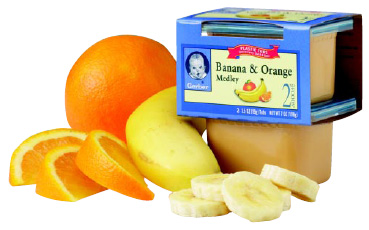
Traditionally, infant food purees have been retorted or hot-filled in glass jars. This remains the case with products containing larger particles sizes, although some of these are packaged in plastic bowls or trays. Aseptically processed purees for infants were first introduced in the U.S. by Gerber in 2001, followed shortly thereafter by Heinz. These consist of popular fruit purees in 4-pack plastic containers. Gerber has recently expanded its offering of fruit purees in 2-pack plastic dishes (Fig. 6).
--- PAGE BREAK ---
• Processing of Infant Cereal. Instant cereal for infants is typically small flakes of single grains or combinations which may be reconstituted with breastmilk, formula, water, or fruit juice. All contain vitamins and minerals, and some contain dried fruit. The traditional process has been drum drying of a slurry which may be treated with added enzymes to improve flavor and digestibility.
Packaging
A wide variety of packages are used for infant and toddler foods. Among them are paperboard cartons, pouches, and canisters for dry cereal; glass jars and plastic bottles for juice; glass jars and plastic dishes for purees; bag-in-box formats and canisters for bakery and snack items; and a range of microwavable plastic dishes for dinners and mealtime combinations.
As with requirements for adult foods, infant and toddler foods are a balance of product requirements, consumer preference, and cost. Plastic packaging is making important in-roads in the category, as evidenced by Gerber’s juices in 4-oz plastic bottles, Gerber’s and Heinz’s fruit purees in plastic dishes, and Gerber Lil’ Entrees in microwavable, heat-seal trays.
For infant and toddler foods, it is generally expected that the caregiver will open and heat the product. Many packages are developed for portability. Some packages are designed for the caregiver as the primary feeder, while others are developed for the infant/toddler as primary feeder. More widespread use of plastic packaging is a trend in the category.
An Important Category
Infant and toddler foods represent an important category of prepared foods. While many aspects of their formulation and manufacture are common to the industry, there are a number of aspects that are unique based on the unique needs and expectations of the target consumer and their caregivers.
by Curt Emenhiser
The author, a Professional Member of IFT, is Manager–New Product Development, Gerber Products Co. (a Novartis Co.), 445 State St., Fremont, MI 49412.
